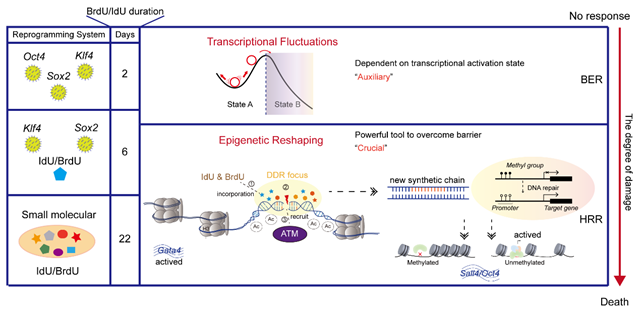Scientists Uncover New mechanisms of BrdU/IdU Induced Epigenetic Reshaping through DNA Damage Repair in Somatic Cell Reprogramming
Recently, the research team led by Prof. LIU Jing at the Guangzhou Institutes of Biomedicine and Health, Chinese Academy of Sciences, published an article titled "Epigenetic reshaping through damage: promoting cell fate transition by BrdU and IdU incorporation"in the journal Cell & Bioscience. The research reveals the molecular mechanisms by which the base analogues BrdU and IdU promote somatic cell reprogramming through DNA damage repair pathways, regulating histone acetylation and DNA demethylation, and establishes the correlation between their dosage and effects across multiple reprogramming systems.
This research is based on the highly efficient chemical reprogramming system with well-defined chemical components previously established by the team. In that system, BrdU plays a crucial role as a base analogue, but its mechanism was not clear. Therefore, this research addresses the key scientific question of how the randomness of base analogues, integrating randomly into the genome, participates in the precise process of somatic cell reprogramming, which is fundamentally an epigenetic reprogramming process, and how it impacts and regulates epigenetic reprogramming.
The research found that BrdU can play a role in two stages of chemical reprogramming and can be substituted by IdU. During the first stage, the transition of somatic cells to an XEN(extraembryonic endoderm)-like intermediate state, continuous treatment with BrdU/IdU causes DNA damage accumulation. Inhibiting the main repair pathway for double-strand breaks, ATM (ataxia telangiectasia-mutated), can significantly reduce the efficiency of chemical reprogramming. The acetylation of key genes in the XEN-like state, such as Gata4, Sox17, and Sall4, is specifically upregulated under base analogue treatment. The activation of ATM leads to a phosphorylation-acetylation cascade, suggesting that base analogues can activate the ATM signaling pathway by inducing DNA damage, leading to the accumulation of acetylation at the damage sites and thus regulating gene expression. In the second stage, during the transition from XEN-like state to pluripotency, DNA methylation is a major limiting factor. The sustained damage caused by base analogues can lead to the demethylation of newly synthesized DNA strands, losing their original methylation modifications.
Finally, after discovering the specific molecular mechanisms of base analogues, the research further validated the universality of this mechanism in factor reprogramming systems and established an efficient somatic cell reprogramming system centered around BrdU with KLF4 and SOX2 (KS). In this system, BrdU can still promote somatic cell reprogramming through the ATM signaling pathway by activating XEN genes. the research also identified the molecular action characteristics of base analogues in different reprogramming systems and summarized the correlation between their dosage and effects.
In summary, the research found that BrdU/IdU can activate the DNA damage repair pathway (HRR), leading to increased histone acetylation and genome-wide DNA demethylation, thereby regulating somatic cell reprogramming. This research reveals the interplay between the genome and epigenetics in somatic cell reprogramming, providing new insights into the mechanisms of cell fate transition.

Brdu and Idu regulate somatic cell reprogramming through DNA damage repair pathways.
(Image by GIBH)
Contacts:
LIU Jing,Ph.D, Principal Investigator;
Guangzhou Institutes of Biomedicine and Health, Chinese Academy of Sciences
Guangzhou, China, 510530
Email:liu_jing@gibh.ac.cn